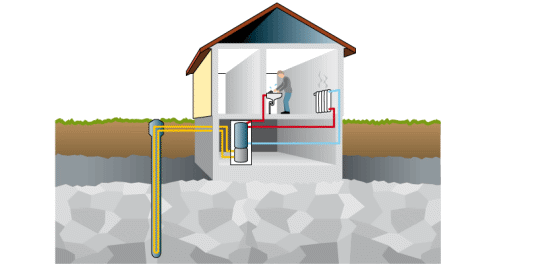Rock (geothermal) heat
The rock source heat pump draws heat from bedrock and groundwater by means of a circulating liquid in a hose in a borehole.

This is the cross-section of a house. The house is heated by a rock source heat pump in the basement. The pump draws heat from a borehole in the ground. The heat pump generates both heat and hot water. Illustration: Bo Reinerdahl
The depth of the borehole is often less than 200 m and the distance between two boreholes is at least 20 m. If the distance is less, the two boreholes may affect and cool one another. The heat available may be 10–30 W/m of borehole.
Rating
A rock source heat pump is rated to meet both the heating and the hot water demand. Rating is normally carried out so that the pump meets 60–70 % of the maximum thermal power demand of the house, which leads to about 90 % of the annual energy demand of the house being covered by the heat pump.
Consider the energy efficiency improvement measures you can take on the house before you have the heat pump rated, since the heat pump is otherwise likely to be over-rated.
Certified drilling contractor
Use a certified drilling contractor to ensure that you will have the hole for the rock source heat pump drilled in a good and reliable way. The certification requirements have been drawn up by the Swedish Geological Investigations (SGU) in cooperation with the Swedish well drillers’ trade organization and the Swedish Avanti drillers’ association. Requirements are made on the experience, knowledge and insurances of the contractor.
Permit is required
To install a rock source heat pump system, you must apply for permission from the municipal environmental and health protection board.


